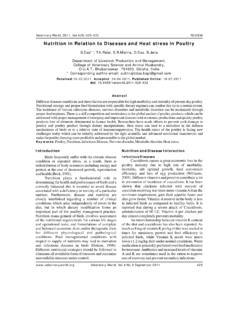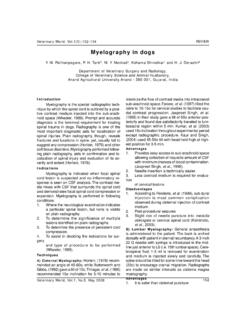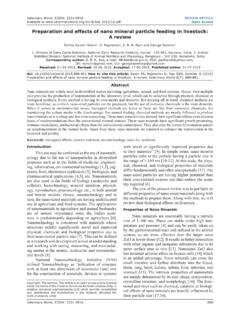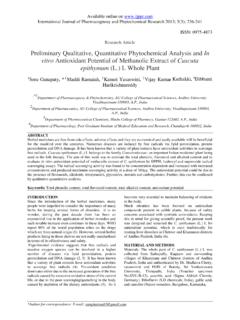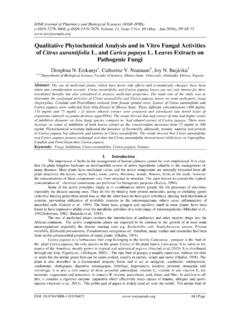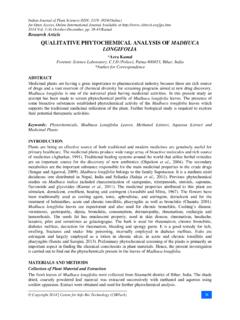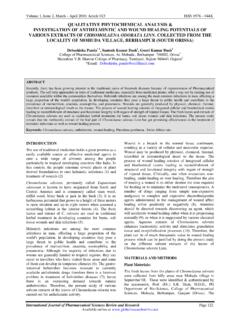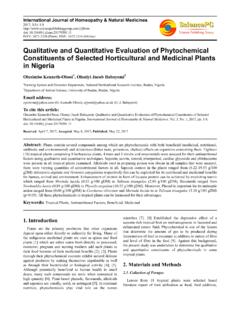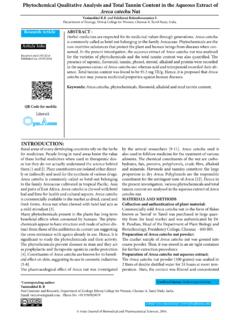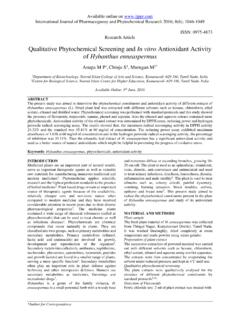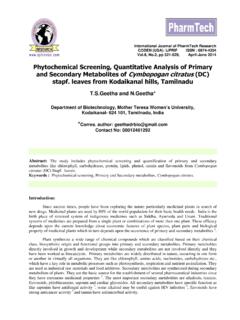Transcription of Qualitative phytochemical screening of Hygrophila spinosa ...
1 Veterinary World (8): 367-368 RESEARCH. Qualitative phytochemical screening of Hygrophila spinosa plant extract S. Mandal*1, G. K. Dutta and Department of Veterinary Biochemistry, College of Veterinary Science & Anjora, Durg, Chattisgarh - 491001, India * Corresponding author email : Abstract The present study was undertaken to find out the phytochemicals present in Hygrophila spinosa plant extract. Fresh leaves and aerial parts of botanically identified plant was collected and were processed for preparation of plant extract using specified technique.
2 The plant extract was then subjected for different Qualitative chemical tests to investigate the chemical profile of H. spinosa extracts. analysis showed the presence of alkaloids, carbohydrates, phenolic compounds and tannins in the extact as confirmed by implying different Qualitative tests specified for these phytochemicals. Keywords: Hygrophila spinosa , plan textract, phytochemicals Introduction were collected in bulk from waterlogged area of the Hygrophila spinosa (Common Bengali name College of Veterinary science and A.)
3 H. campus, Kullakhara ; Hindi name Tal-Makhana , Gokulakanta; Anjora, Durg during the month of October- November Local name Mokhla ; Sanskrit name Kokilaksha ; in the year 2008. Cleaned leaves and aerial parts were German name Langblattriger Steindorn ) is a semi- then dried under shade and were ground into a fine woody herb of Acanthacea family, an inhabitant of powder form using domestic mixer grinder machine. damp or swampy area found throughout the planes of The fine powder of the plant leaves and aerial parts India (Hooker, 1885).
4 Hygrophila spinosa is a obtained was stored in air tight containers for further commonly found herb in India, being used as vegetable processing. in some states. Vegetation commences in the rainy Preparation of extracts: Traditionally the hot water season and flowering in autumn. The aerial part is infusion of fresh plant materials is used to increase the commonly consumed as a vegetable. Different parts haemoglobin level. The powdered leaves and aerial (leaves, roots, seeds) of the herb are used in several parts of H.
5 spinosa were processed to obtain patho-physiological conditions such as jaundice, concentrate hot water infusion extracts as described rheumatism, renal stone, gonorrhoea, hepatic below: disorders, anti-tumor activity (Chopra et al., 1956). It is Dried powdered leaves and aerial parts of the a common practice to feed the hot water infusion of plant (80 g) was dispersed in boiled distilled water and succulent aerial parts of pre-flowering and flowering cooled at room temperature in a closed glass container. plant to increase haemoglobin level in anaemia and The content was filtered with the help of double layered pregnant women to prevent anaemia.
6 Some reports muslin cloth and the water infusion was collected. The are available on composition of roots and seeds but no solution was centrifuged at 5000 rpm for 10 minutes reports are available on the composition hot water and the supernatant was collected for drying in the infusion of leaf and aerial part of the plant. Due to rotary vacuum evaporator (MAC Rotary Vacuum paucity reference the present investigation was Evaporator, BUCHI Type; MSW-191) at 600C. undertaken and different Qualitative chemical tests temperature and low pressure.
7 After complete were perform for establishing profile of H. spinosa hot evaporation of the water the weight of the extracts was water extract (flowering stage) for its chemical noted and the percent (%) of recovery of extracts was composition. recorded on the dry weight basis. The extract was kept in air tight container and preserved in a refrigerator for Materials and Methods further use. Plant materials: Fresh leaves and aerial parts of Qualitative phytochemical screening : Following botanically identified H. spinosa at its flowering stage different Qualitative chemical tests were performed to Veterinary World, August 2010 367.
8 Qualitative phytochemical screening of Hygrophila spinosa plant extract investigate the chemical composition of H. spinosa Hygrophila spinosa contains alkaloids extracts. (Majumdar and Sengupta, 1978) corroborated with the 1. Detection of alkaloids By Mayer's test (Evans, present result. Additional to this carbohydrates, 1997), Wagner's test (Wagner, 1993), Hager's phenolic compounds and tannins were also detected in reagent (Wagner et al., 1996), Dragendroff's the extract contradict the result of previous worker who reagent (Waldi, 1965).
9 Repor ted presence of phytosterol, nitrogen, 2. Detection of saponins (Kokate, 1999). albuminoids, alkaloids, essential oils, myrastic, 3. Detection of carbohydrates and glycosides palmatic, stearic and linolic acids (Majumdar and (Ramkrishnan et al., 1994): Carbohydrates Sengupta, 1978). detection by Molish's test, Benedict's test, Acknowledgment Barfoed's test and for detection of Glycosides Bortrager test (Evans, 1997), Legals test. The authors are highly acknowledged to the 4. Detection of proteins and amino acids ( Fisher, Dean college of Vety.)
10 Sci. & , Anjora, Durg (CG), for 1968; Ruthmann, 1970): Biuret reagent (Gahan, providing funds and facility for this research. 1984), Ninhydrin reagent (Yasuma and Ichikawa, References 1953). 1. Chopra, N. R., Nayar, S. L. and Chopra I. C. (1956): 5. Detection of phytosterols (Finar,1986). Glossary of Indian Medicinal Plant. (CSIR, New Delhi). 6. Phenolic compound and Tannins: Ferric chloride 29. test, Alkaline reagent test. 2. Evans, (1997): Trease and Evans Pharmacology. 7. Fixed oils and fat (Kokate, 1999): By Spots test.
